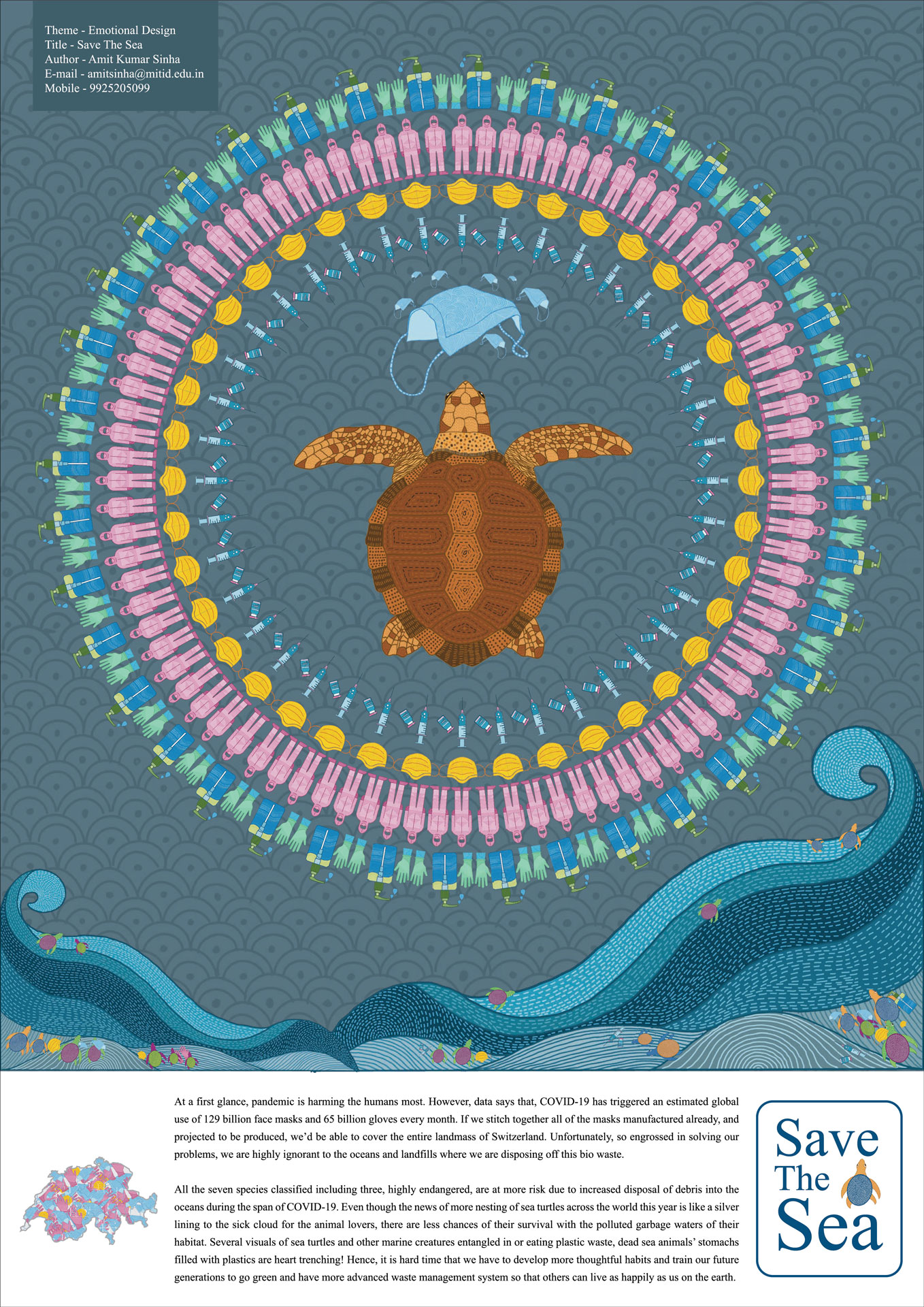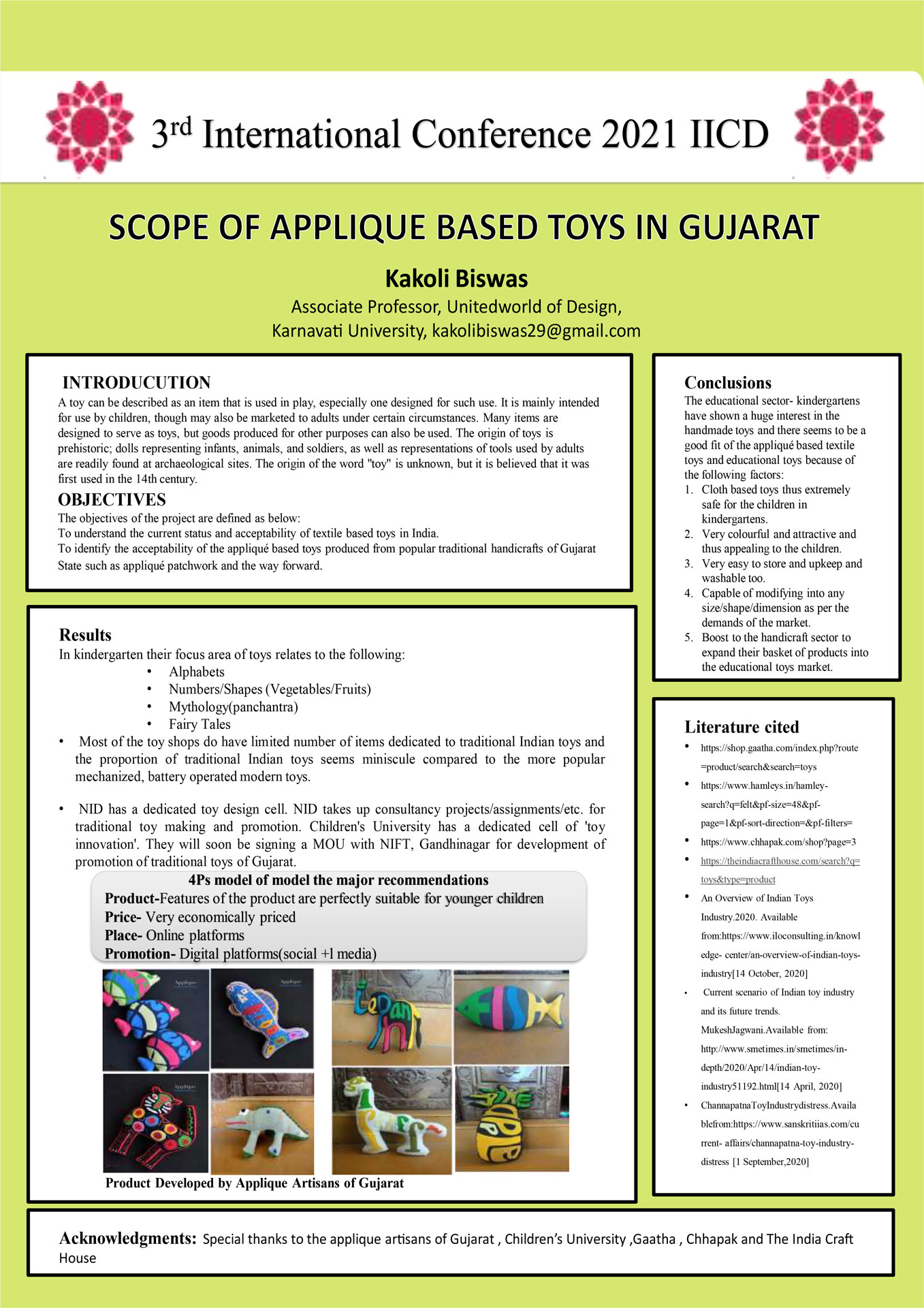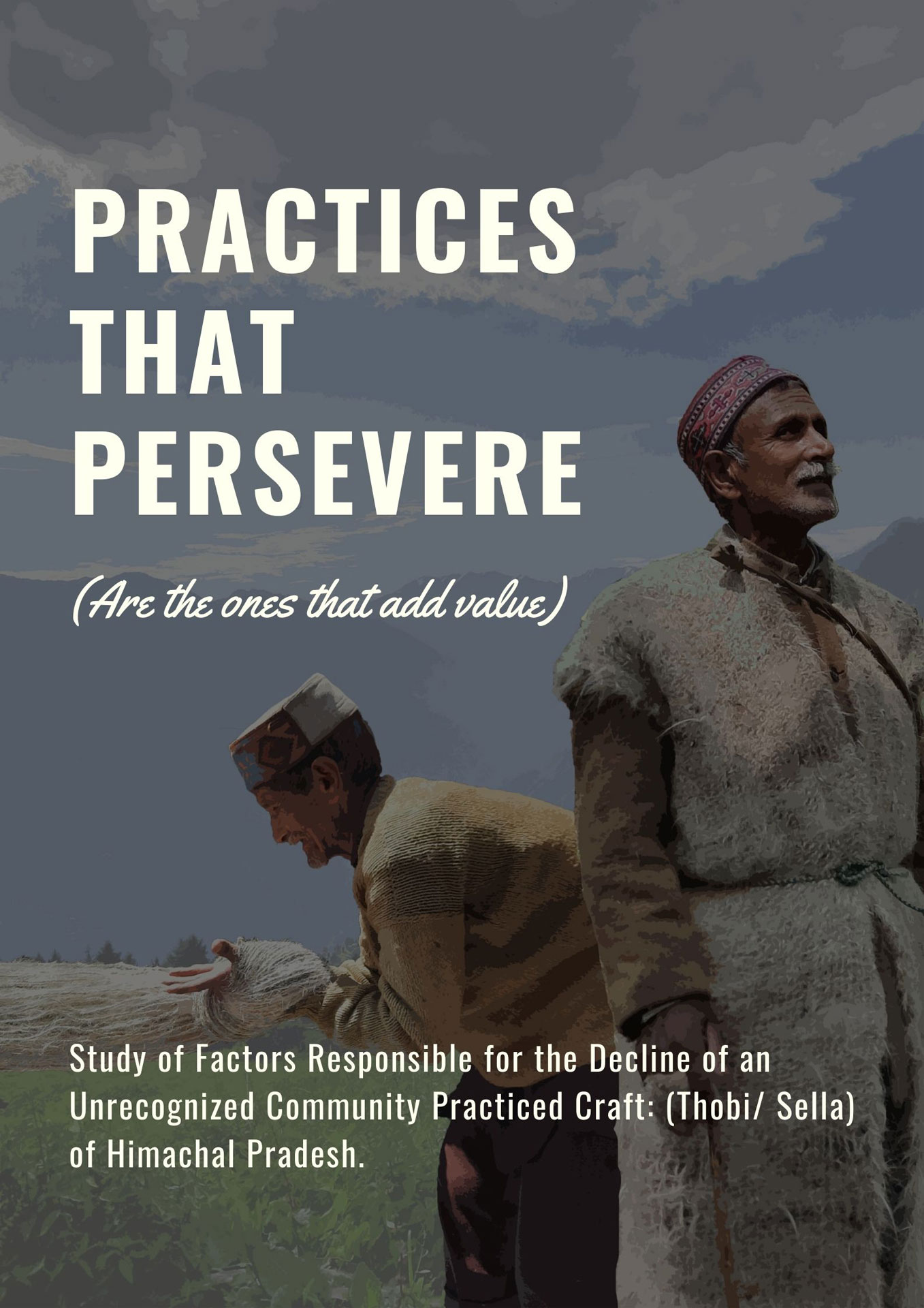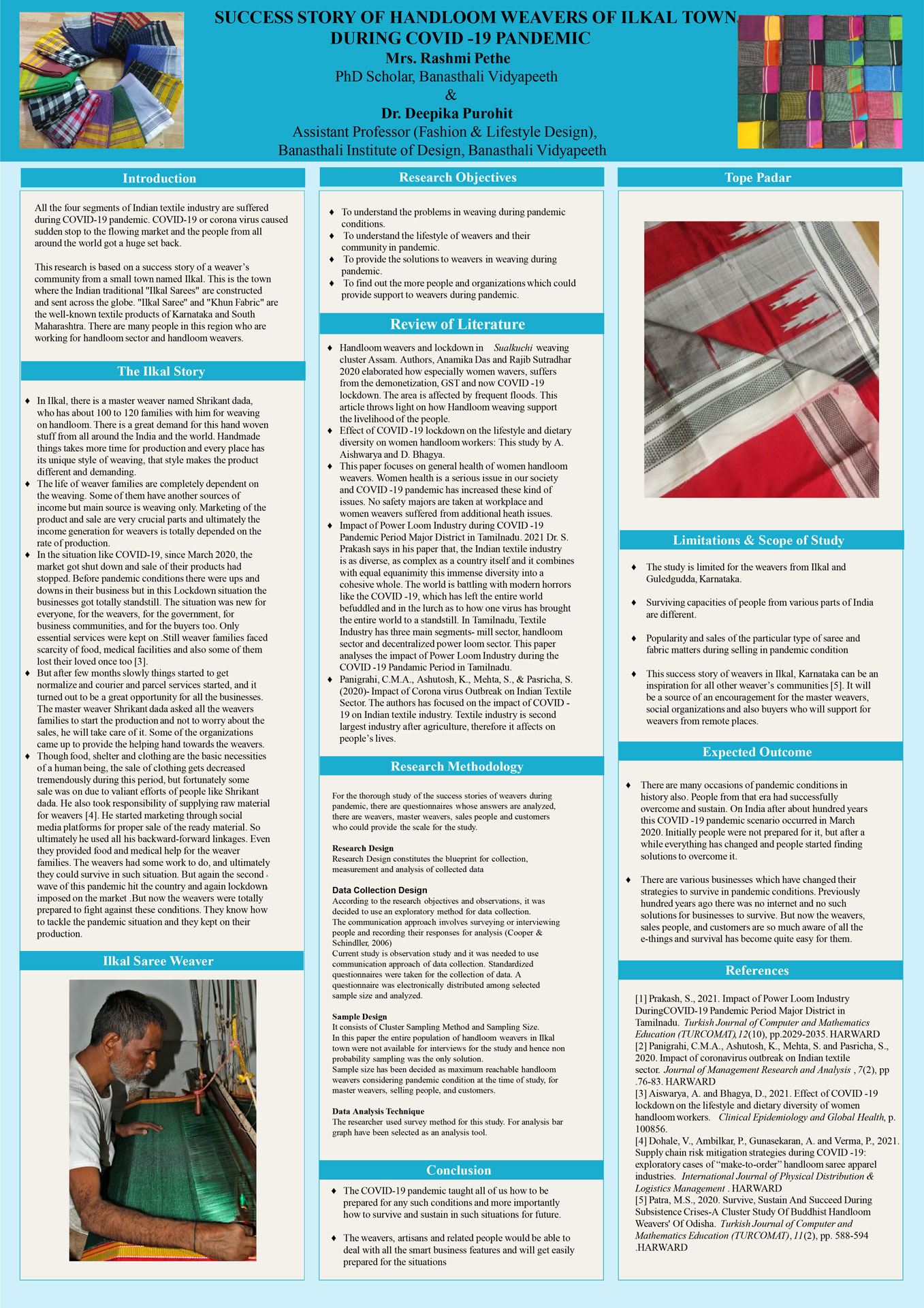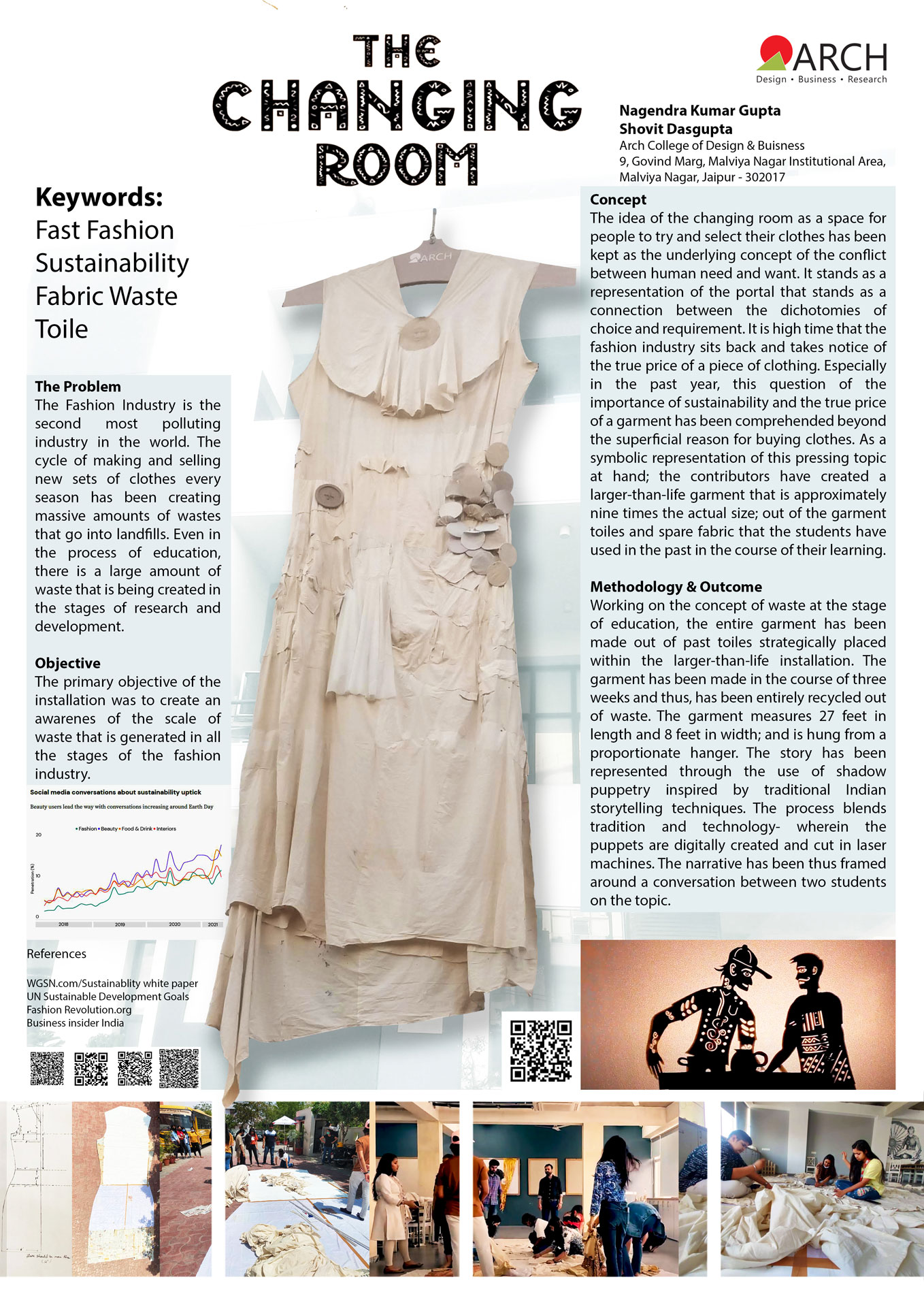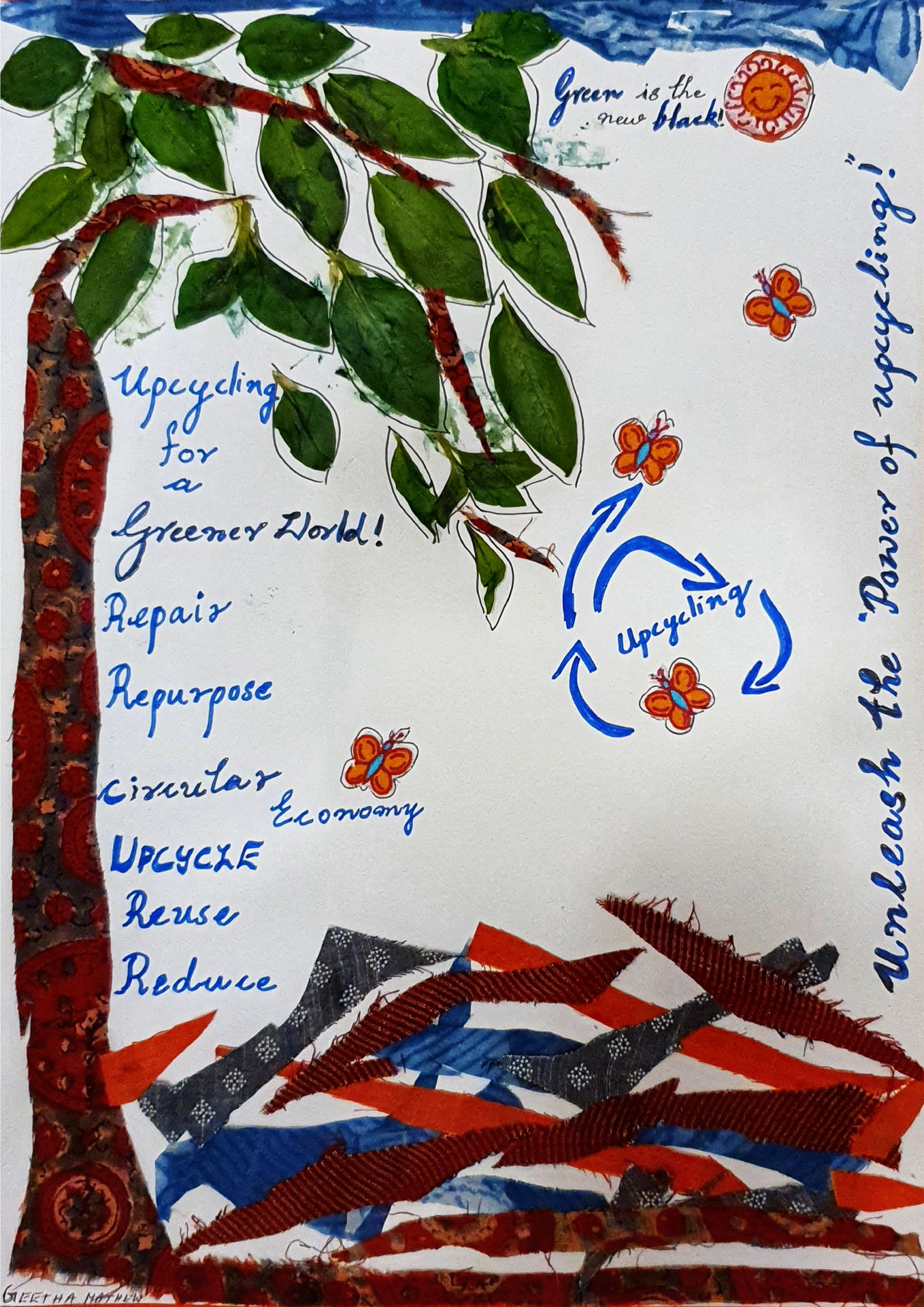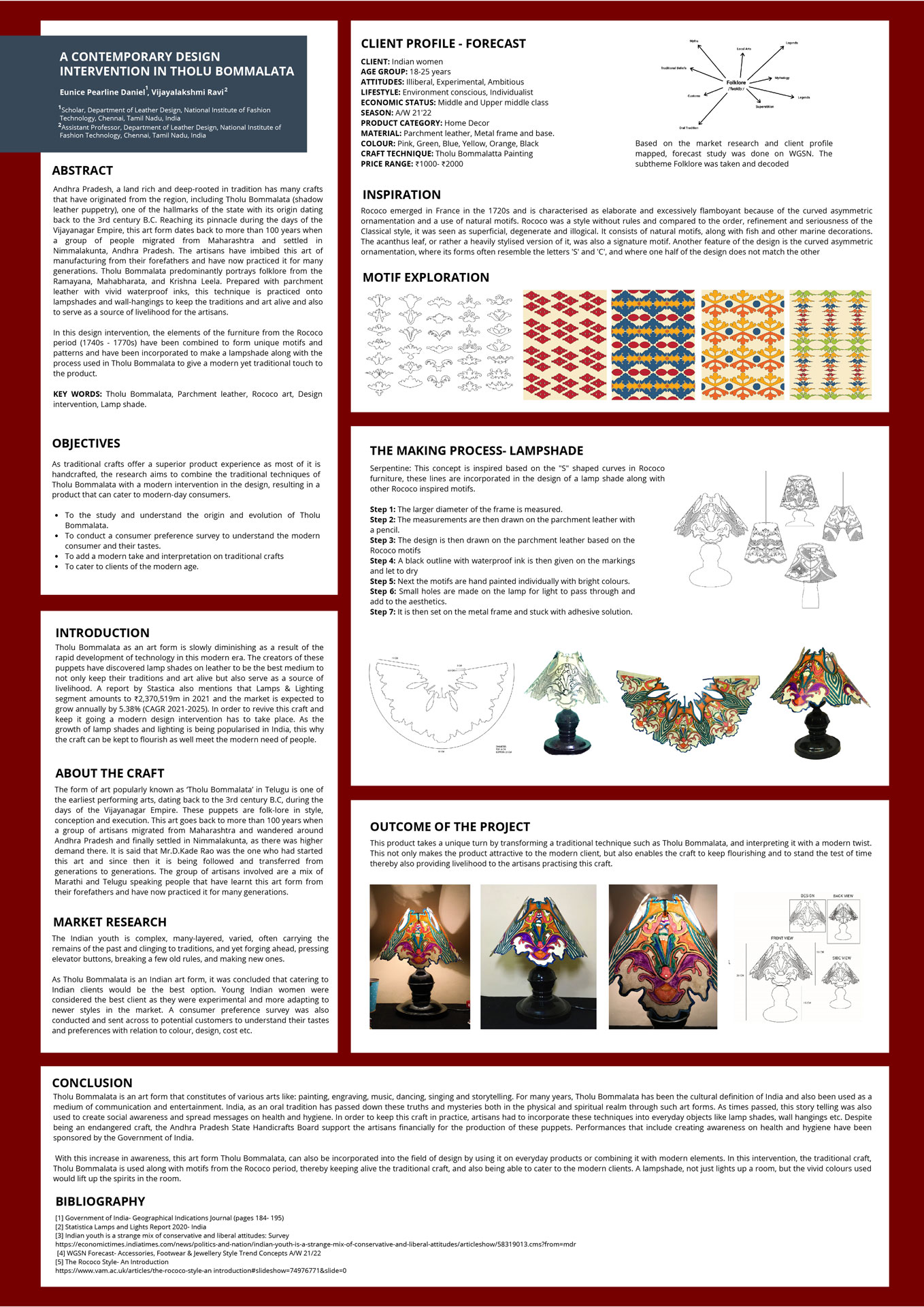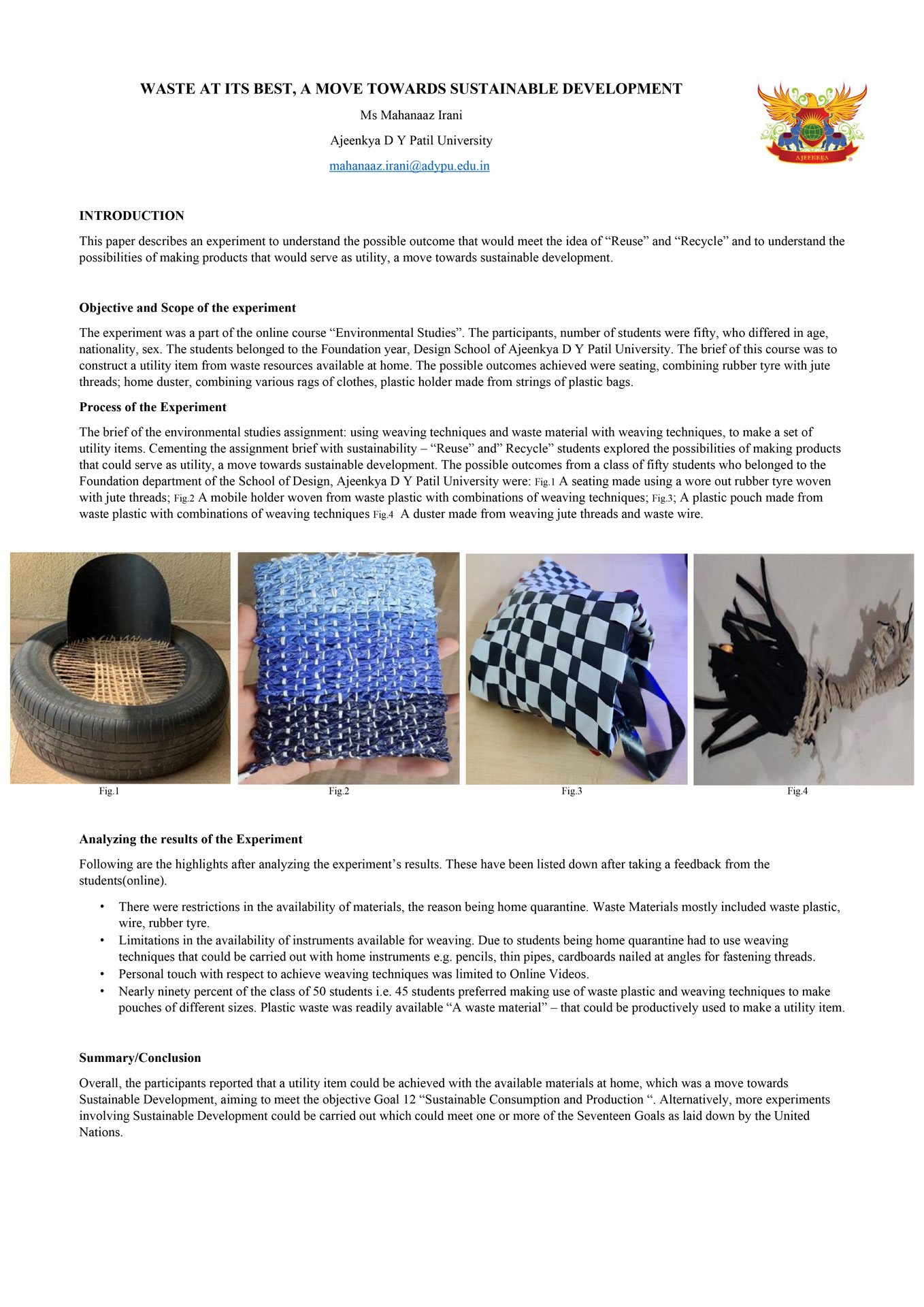9. Save the Sea by Amit K. Sinha, MIT ADT University
At a first glance, pandemic is harming the humans most. However, data says that, COVID-19 has triggered an estimated global use of 129 billion face masks and 65 billion gloves every month. If we stitch together all of the masks manufactured already, and projected to be produced, we’d be able to cover the entire landmass of Switzerland. Unfortunately, so engrossed in solving our problems, we are highly ignorant to the oceans and landfills where we are disposing off this bio waste. This ignorance has created massive issues for the creatures like sea turtles who mistakenly consume our thrown gloves and masks that resemble its favourite food jellyfish under the water. When it comes to the rapid rise in single-use plastic resulting from COVID-19, the story gets even more complicated. All sea turtle species are at risk from plastic. Tragically, the accumulation of plastics at key nesting beaches makes the baby turtles among the most at risk from plastic entanglement, preventing them from reaching the sea.- Key Words: COVID-19, Medical Waste, Ocean Pollution, Endangered Animals.
10. Scope of Applique Based Toys in Gujarat by Kakoli Biswas, Karnavati University
A toy can be described as an item that is used in play, especially one designed for such use. It is mainly intended for use by children, though may also be marketed to adults under certain circumstances. Playing with toys can be an enjoyable means of training young children for life in society. Different materials like wood, clay, paper, and plastic are used to make toys. India is an old playground of a myriad of toys made from a variety of materials like wood, polymer, cloth, fibre, wood pulp, rubber and metal. In Gujarat wooden toys, etc are found in the Patan cluster and apart from that there already exists a tradition of cloth dhinglas and dhinglis (dolls) are often made from small pieces of waste fabrics called thigdas or patchwork. One of the oldest and finest crafts of Gujarat, patch work and applique use patches of fabrics stitched together to create floral and animal designs. An applique is ornamental needlework in which pieces of fabric in different shapes and patterns are sewn or stuck onto a larger piece to form a picture or pattern. History of Applique work in India can be traced as back as the times when the women folk of the native communities of north Gujarat; the Kathis (the land owners), the Mahajans (the businessmen), the Rabaris (the nomad camel herders) and the Muslims produced large canopies, hangings, friezes, bullock-covers (Jhul), tents for ox-carts with human and animal figures stitched on them. These designs are used to decorate quilts, wall hangings, modern household products and apparels. Already applique craftsmen in Ahmedabad have started making soft toys along with their traditional quilts, pillows, etc. These soft toys are more of an educational toy for kids. This paper attempts to study the scope of acceptability of applique based toys of Gujarat for innovative toy making which in turn promotes Indian traditional crafts and traditions. The educational sector- kindergartens have shown a huge interest in the handmade toys and there seems to be a good fit of the applique based textile toys and educational toys because of many factors such as colorful, attractive, safety, affordable, etc.- Keywords - Age-old Craft, Applique, Patchwork, Toys, Traditional, Design, Educational
11. Study of Factors Responsible for the Decline of an Unrecognized Community Practiced Craft: (Thobi/ Sella) of Himachal Pradesh by Rikita Thakur, NID Gandhinagar
Some of our country’s oldest semi-nomadic pastoral communities, the Gaddi shepherds and Kulluvi shepherds feel the pressure of change - climatic, environmental & social. This change is leading to the decline of traditional occupation, indigenous knowledge, and practices of the shepherd community. This paper mainly focuses on the study of the traditional knowledge of making goat hair products and their decline through analysis of the living spaces and clothing of these shepherds across the annual cycle of nomadic migration with their flocks. An empirical approach was used for the research conducted during the month of March in the Chamba and Kullu districts of Himachal Pradesh. The research reveals & reconfirms that a certain craft practice emerges to develop as a response to physical, social, cultural, or economic need. In absence of said need, the craft and its related practices lose their meaning, identity and, with time, their presence.- Keywords - Endangered, Shepherd Community of Kullu and Chamba, Handicrafts, Lifestyle, Goat Hair, Thobi/sella (carpet)
12. Success Story of a Family of Handloom Weaver from Ilkal Karnataka, During COVID by Rashmi Pethe & Dr. Deepika Purohit, Banasthali Institute of Design
Handloom sector is facing many challenges in pandemic. This research is based on the detailed study and analysis done in personal visit to Ilkal, Karnataka, the place of handloom weavers. This paper explores the survival and sustainability of the handloom weavers in lockdown situation, by using new technologies, schemes, training of handling these technologies and getting help from NGO’s. Direct visit and interviewing weaver’s family members, master weavers, traders and customers was the best way to do it. Due to pandemic situation, there was limitation to visit more weaver’s families. Communication, Buying & selling, money transactions can all happen by adopting new methods and technologies. The special trainings should be provided to the weavers, craftsmen, traders, by which these people should not stop production in pandemic and they all have not only survive but sustain. This paper aims to help and show ways to overcome and conquer the pandemic conditions and how to tackle the social-financial crises situation for the craft people. This will also a collective initiative for the handloom weavers to make them strong in any depraved condition.- Keywords - Ilkal, Handloom Weavers, Pandemic, Technology
13. Sustainability of Traditional Pattachitra Painting of Raghurajpur of Puri, Odisha in the Era of COVID-19 Pandemic by Dr. Sasmita Panda, NIFT, Hyderabad
India is a home to the largest number of handicrafts artisans among all the nations in the globe. It is also home to some of the brilliantly hand crafted products with an array of breath taking colours, incredibly crafted with an exception al appeal. The multifaceted diversity in the handicraft sector is a complex entity which most people think does not warrant revitalisation. But its contribution cannot be overlooked. The Pattachitra painting of Raghurajpur village in Puri district of Odisha is one such master piece of handicraft which cannot be overlooked but to be revitalised only. Raghurajpur is a small village situated in between the capital city of Bhubaneswar and the famous temple town of Puri on the beach (Bay of Bengal). It is at a distance of about 45 kms on the national highway from Bhubaneswar and about 10 kms before Puri.- Keywords - Ritualistic, Rath Yatra, Puri, Jagannath, Vegetable Colour
14. The Changing Room- Change to Reflect: Precept by Nagendra Kumar Gupta & Shovit Dasgupta, Arch College of Design and Business
The Fashion Industry is the second most polluting industry in the world. The price of fast fashion has been continuously paid by the environment. The cycle of making and selling new sets of clothes every season has been creating massive amounts of wastes which go into landfill. The post-modern society of today with its demand and supply chain has created piles of waste that is continually dumped into the environment. The idea of the changing room as a space for people to try and select their clothes has been kept as the underlying concept of the conflict between the human need and want. It stands as a representation of the portal that stands as a connection between the dichotomies of choice and requirement. It is high time that the fashion industry sits back and takes notice of the true price of a piece of clothing. Especially in the past year, this question of the importance of sustainability and the true price of a garment has been comprehended beyond the superficial reason for buying clothes. As a symbolic representation of this pressing topic at hand; the contributors have created a larger-than-life garment which is approximately nine times the actual size; out of the garment toiles and spare fabric that the students have used in the past in the course of their learning. Working on the concept of waste at the stage of education, the entire garment has been made out of past toiles strategically placed within the larger-than-life installation. The garment has been made in the course of three weeks and thus, has been entirely recycled out of waste. The garment measures 26 feet in length and 8 feet in width; and will be hung from a proportionate hanger. Thus, this piece stands as an inquiry into the stages of making a garment; and poses the pertinent question of the true price of Fashion.- Keywords - Fast Fashion, Sustainability, Fabric Waste, Toile
15. The Power of Upcycling by Geetha Mathew, Aranya Natural
The implementation and practice of upcycling are not so daunting once you put systems to address wastages as we at Aranya Natural discovered in 2020. When the pandemic hit the world, like many other brands, we also re-exam ined our practices so that we could reinvent ourselves and make our operations more sustainable. We upcycled a backlog of yardage, sarees, fabric bits, yarn, etc into gorgeous products by innovative application of existing techniques and resources. These under normal circumstances would have remained unused due to time constraints while fulfilling our orders. Our journey of upcycling has been an exceptionally productive one that promises us to make our model economically viable while taking many steps forward towards creating sustainable and zero waste operations.- Keywords- Upcycling, Circular Solutions, Sustainability , Waste Reduction.
16. Tholu Bommalata- a Contemporary Design Intervention by Eunice Pearline Daniel, NIFT Chennai
As traditional crafts offer a superior product experience as most of it is hand crafted, the research aims to combine the traditional techniques of Tholu Bommalata with a modern intervention in the design, resulting in a product that can cater to modern-day consumers. OBJECTIVE OF THE INNOVATION: To the study and understand the origin and evolution of Tholu Bommalata. To conduct a market survey to understand the modern consumer and their tastes. To add a modern take and interpretation on traditional crafts. To cater to clients of the modern age.- Keywords - Tholu Bommalata, Parchment Leather, Rococo Art, Design Intervention, Lamp Shade.
17. Waste at its Best, a Move Towards Sustainable Development by Mahanaaz Irani, Ajeenkya D Y Patil University, Lohegaon, Pune
Online learning has been fast evolving as a platform for teaching courses independent of geographical boundaries. The pandemic Covid 19 caused a complete lockdown in education sector world over. With the human vocabulary revolving around, quarantine, lockdown, covid the author wanted to work around these words cementing it with sustainability Reuse & Recycle. Taking this idea further the author explored the possibilities of making products that could serve as utility, a move towards sustainable development. With the limitations of home constants and making use of available resources, the author wanted to explore the possibilities whether the possible outcomes could also contribute towards meeting any of the Sustainable Development Goals laid done by the United Nation and also whether the possible outcome met the idea of Reuse & Recycle. The experiment was a part of the online course Environmental Studies. The number of students participation were fifty, who differed in age, nationality, sex. The students belonged to the Foundation year, Design School of Ajeenkya D Y Patil University. The brief of this course was to construct a utility item from waste resources available at home. The possible outcomes achieved were a seating, combining rubber with jute threads; home duster, combining various rags of clothes, plastic holder made from strings of plastic bags. The results met the 12th Sustainable Development Goal laid down by the UN; Responsible Consumption and Production. There were some limitations which were noted, students had limited resources to work as a result of the quarantine, personal touch was lacking from the mentor side when it came to showing weaving techniques. Feedbacks from the students reflected the waste at home could be productively used, a move towards sustainability and foster the growth towards Reuse and Recycle. However, there is more scope of conducting such experiments which could meet the concept of Reuse and Recycle and have the possibility to meet one or more of the seventeen Sustainable Development Goals laid down by the United Nations.- Keywords - Sustainability, Waste, Reuse, Recycle


